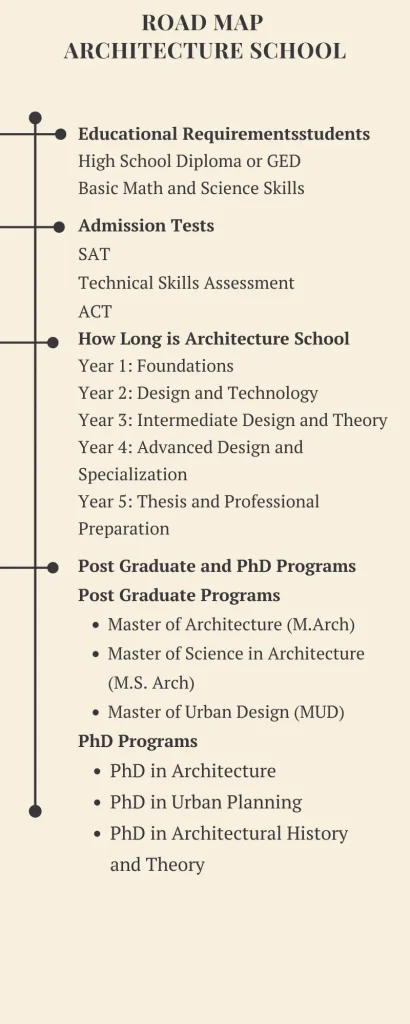How Long is Architecture School
How Long is Architecture School? Architecture school typically takes five to seven years to complete, depending on the country and specific program. In the United States, students usually undergo a five-year Bachelor of Architecture (B.Arch) program or pursue a four-year undergraduate degree followed by a two-year Master of Architecture (M.Arch) program.
What is Architecture School
Architecture school is an educational institution where students learn the art and science of designing buildings and structures. The curriculum covers a wide range of subjects including architectural history, design theory, building technology, and environmental sustainability. Students engage in studio work, creating detailed drawings and models to develop their design skills and technical knowledge.

In addition to theoretical courses, architecture school often involves practical training through internships or hands-on projects. This combination of classroom learning and real-world experience prepares students for professional practice in the field. Graduates from architecture school can pursue careers as licensed architects, urban planners, or designers, contributing to the built environment in various capacities.
How Long is Architecture School
Year 1: Foundations
The first year focuses on foundational skills and knowledge. Students take introductory courses in architectural history, design principles, and basic drawing techniques. They learn to think critically about space and form while developing their ability to communicate ideas visually.
Year 2: Design and Technology
In the second year, students delve deeper into architectural design and technology. They engage in more complex design projects, studying building materials, structural systems, and construction methods. Courses in computer-aided design (CAD) and digital modeling are also introduced.
Year 3: Intermediate Design and Theory
The third year emphasizes intermediate design studios and architectural theory. Students tackle larger-scale projects, integrating their technical and theoretical knowledge. They also explore topics like environmental sustainability, urban planning, and building codes, which are essential for responsible design practices.
Year 4: Advanced Design and Specialization
In the fourth year, students focus on advanced design studios and begin to specialize in areas of interest such as urban design, landscape architecture, or sustainable design. They work on comprehensive projects that require detailed research, site analysis, and innovative solutions.
Year 5: Thesis and Professional Preparation
The final year is dedicated to the thesis project, where students develop a comprehensive design proposal on a topic of their choice. This capstone project demonstrates their mastery of architectural principles and design skills. Additionally, students prepare for professional practice by taking courses in project management, ethics, and preparing for licensure exams.

How to Enter Architecture School
Educational Requirements for Architecture School
High School Diploma: Completion of high school or an equivalent is required.
Prerequisite Courses: Courses in mathematics (especially geometry and calculus), physics, and art/design are often recommended.
Portfolio: Many programs require a portfolio showcasing your creative work, including drawings, models, or other art projects.
Entry Tests for Architecture School
SAT/ACT: Standardized test scores may be required, depending on the country and specific program.
Subject Tests: Some schools may ask for subject-specific tests, particularly in math or science.
English Proficiency Tests: For non-native English speakers, tests like TOEFL or IELTS may be required.
Application Process for Architecture School
Online Application: Most schools have an online application portal where you fill in your personal information, academic history, and other relevant details.
Personal Statement: A written statement explaining your interest in architecture and your career aspirations.
Letters of Recommendation: Typically, 2-3 letters from teachers, mentors, or professionals who can attest to your abilities and character.
Interview: Some programs may require an interview, either in person or via video call, to assess your suitability for the program.
Financial Aids for Architecture School
Scholarships: Many institutions offer merit-based and need-based scholarships specifically for architecture students.
Grants: Government and private organizations may provide grants to help cover tuition and other expenses.
Loans: Federal and private student loans are available, though they must be repaid with interest.
Work-Study Programs: These programs allow students to work part-time jobs, often within the university, to help fund their education.
Assistantships: Some graduate programs offer teaching or research assistantships that provide a stipend and tuition remission in exchange for work.
Postgraduate and PhD Programs
Post Graduate Programs for Architecture School
Master of Architecture (M.Arch)
Duration: Typically 2-3 years.
Curriculum: Advanced design studios, architectural theory, history, technology, and professional practice. Some programs offer specializations in areas such as urban design, sustainable architecture, or digital design.
Prerequisites: Bachelor’s degree in architecture or a related field, portfolio of work, letters of recommendation, statement of purpose, and GRE scores (if required).
Outcome: Prepares students for licensure and professional practice as architects.
Master of Science in Architecture (M.S. Arch)
Duration: Typically 1-2 years.
Curriculum: Research-focused, with an emphasis on advanced topics like architectural technology, building performance, computational design, or urban studies.
Prerequisites: Bachelor’s degree in architecture or a related field, research proposal, portfolio, letters of recommendation, and GRE scores (if required).
Outcome: Prepares students for careers in research, academia, or specialized professional practice.
Master of Urban Design (MUD)
Duration: Typically 1-2 years.
Curriculum: Focus on urban planning, sustainable urban development, and the design of urban spaces.
Prerequisites: Bachelor’s degree in architecture, urban planning, or a related field, portfolio, letters of recommendation, and GRE scores (if required).
Outcome: Prepares students for careers in urban design and planning, both in the public and private sectors.
PhD Programs for Architecture School
PhD in Architecture
Duration: Typically 3-6 years.
Curriculum: Extensive coursework in architectural theory, history, and research methods, followed by original research leading to a dissertation.
Prerequisites: Master’s degree in architecture or a related field, research proposal, letters of recommendation, and GRE scores (if required).
Outcome: Prepares students for careers in academia, advanced research, or high-level consultancy.
PhD in Urban Planning
Duration: Typically 3-6 years.
Curriculum: Advanced study in urban theory, policy analysis, and planning methodologies, culminating in a dissertation based on original research.
Prerequisites: Master’s degree in urban planning, architecture, or a related field, research proposal, letters of recommendation, and GRE scores (if required).
Outcome: Prepares students for academic careers, research positions, and leadership roles in urban planning and policy-making.
PhD in Architectural History and Theory
Duration: Typically 3-6 years.
Curriculum: Focused on the historical and theoretical aspects of architecture, involving extensive research and dissertation work.
Prerequisites: Master’s degree in architecture, art history, or a related field, research proposal, letters of recommendation, and GRE scores (if required).
Outcome: Prepares students for careers in academia, museums, and cultural heritage organizations.
Top 10 Architecture Schools

1.Massachusetts Institute of Technology (MIT)
Location: Cambridge, Massachusetts, USA
Notable for: Cutting-edge research, interdisciplinary approach, and strong emphasis on innovation and technology in architecture.
2.Harvard University Graduate School of Design (GSD)
Location: Cambridge, Massachusetts, USA
Notable for: Comprehensive curriculum, world-renowned faculty, and a strong focus on urban design and sustainability.
3.Delft University of Technology (TU Delft)
Location: Delft, Netherlands
Notable for: Strong emphasis on engineering and technology, innovative design practices, and international collaborations.
4.University of California, Berkeley (UC Berkeley)
Location: Berkeley, California, USA
Notable for: Focus on social responsibility, sustainability, and urban design, along with strong research programs.
5.ETH Zurich (Swiss Federal Institute of Technology)
Location: Zurich, Switzerland
Notable for: Rigorous technical training, innovative research, and a strong connection to engineering and technology.
6.University of Cambridge
Location: Cambridge, England
Notable for: Historic reputation, interdisciplinary approach, and strong focus on architectural theory and history.
7.University College London (UCL) – Bartlett School of Architecture
Location: London, England
Notable for: Innovative design studios, research excellence, and a focus on urbanism and sustainability.
8.Columbia University Graduate School of Architecture, Planning and Preservation (GSAPP)
Location: New York City, New York, USA
Notable for: Emphasis on urban design, global perspective, and integration of digital technologies in design.
9.University of Tokyo
Location: Tokyo, Japan
Notable for: Cutting-edge research, integration of traditional and modern design principles, and strong emphasis on sustainability.
10.National University of Singapore (NUS)
Location: Singapore
Notable for: Strong focus on tropical architecture, sustainability, and urban planning in a rapidly developing region.
These schools are renowned for their comprehensive architecture programs, distinguished faculty, and contributions to the field through research and innovation.
Factors Affecting the Length of Architecture School
Degree Type
Bachelor of Architecture (B.Arch): Typically takes 5 years.
Bachelor of Science/Arts in Architecture: Usually 4 years, often followed by a 2-year Master of Architecture (M.Arch).
Country and Educational System
Different countries have varying requirements and educational structures. For example, in the US, the B.Arch is a 5-year program, while in the UK, a combination of a 3-year undergraduate degree and a 2-year M.Arch is common.
Accreditation and Licensure Requirements
Programs accredited by bodies such as NAAB (National Architectural Accrediting Board) in the US may have specific coursework and duration requirements.
Licensure often requires a professional degree (B.Arch or M.Arch) plus a certain amount of internship hours, which can influence the overall length of education and training.
Program Structure and Curriculum
Some schools offer accelerated or integrated programs that combine undergraduate and graduate studies, potentially shortening the total duration.
The inclusion of co-op programs, internships, or study-abroad opportunities can extend the length of time to complete the degree.
Student’s Prior Education
Students with prior degrees or transfer credits may complete their programs faster.
Those entering with little or no relevant background may need to take additional foundational courses.
Part-time vs. Full-time Enrollment
Part-time students may take longer to complete their degrees due to a reduced course load each semester.
Full-time students typically follow a more structured and faster-paced curriculum.
Individual Pace and Circumstances
Personal circumstances, such as the need to work while studying, health issues, or family responsibilities, can affect the time taken to complete the program.
Some students may take breaks or gap years, extending the duration of their education.
Thesis or Final Project Requirements
The time required to complete a thesis or final project can vary greatly among students, potentially influencing the overall duration of the program.
School’s Academic Calendar
Schools with different academic calendars (semester vs. quarter systems) can affect the pacing and scheduling of courses, impacting the time to graduation.
Understanding these factors can help prospective students plan their educational paths and set realistic expectations for the time required to complete their architecture degrees.
Final Verdict
The length of architecture school varies based on degree type, country, program structure, and individual circumstances. Understanding these factors helps students plan their education effectively, ensuring they meet all requirements for a successful career in architecture.
FAQs
1.How long does it take to complete an architecture degree?
Typically, 5-7 years, depending on the degree and country.
2.What are the main entry requirements for architecture school?
High school diploma, prerequisite courses, portfolio, standardized test scores, and letters of recommendation.
3.Are there financial aids available for architecture students?
Yes, scholarships, grants, loans, work-study programs, and assistantships are available.
4.What is included in the curriculum of architecture school?
Courses in design, history, technology, sustainability, and hands-on studio work.
5.What are the top architecture schools globally?
MIT, Harvard GSD, TU Delft, UC Berkeley, and ETH Zurich, among others.
